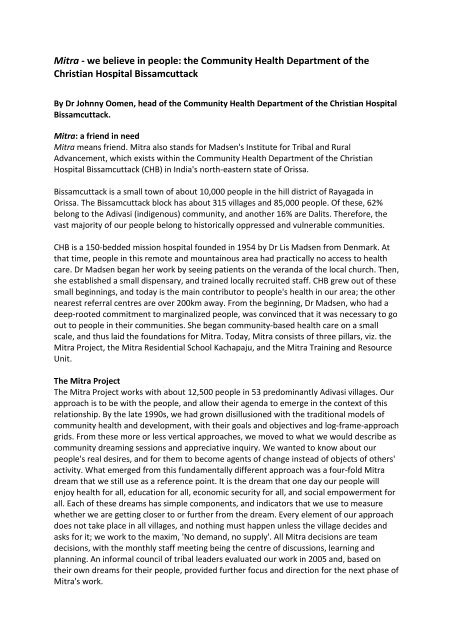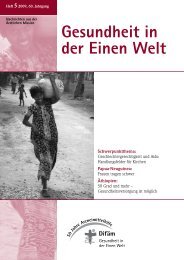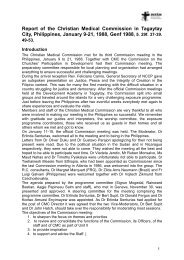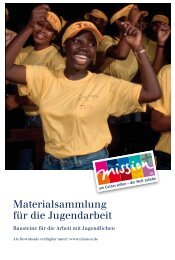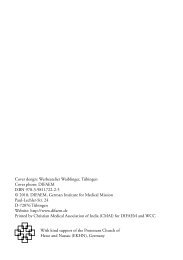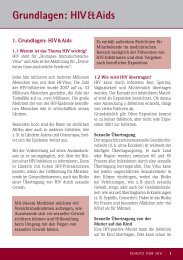Mitra - we believe in people: the Community Health Department of ...
Mitra - we believe in people: the Community Health Department of ...
Mitra - we believe in people: the Community Health Department of ...
You also want an ePaper? Increase the reach of your titles
YUMPU automatically turns print PDFs into web optimized ePapers that Google loves.
<strong>Mitra</strong> - <strong>we</strong> <strong>believe</strong> <strong>in</strong> <strong>people</strong>: <strong>the</strong> <strong>Community</strong> <strong>Health</strong> <strong>Department</strong> <strong>of</strong> <strong>the</strong><br />
Christian Hospital Bissamcuttack<br />
By Dr Johnny Oomen, head <strong>of</strong> <strong>the</strong> <strong>Community</strong> <strong>Health</strong> <strong>Department</strong> <strong>of</strong> <strong>the</strong> Christian Hospital<br />
Bissamcuttack.<br />
<strong>Mitra</strong>: a friend <strong>in</strong> need<br />
<strong>Mitra</strong> means friend. <strong>Mitra</strong> also stands for Madsen's Institute for Tribal and Rural<br />
Advancement, which exists with<strong>in</strong> <strong>the</strong> <strong>Community</strong> <strong>Health</strong> <strong>Department</strong> <strong>of</strong> <strong>the</strong> Christian<br />
Hospital Bissamcuttack (CHB) <strong>in</strong> India's north-eastern state <strong>of</strong> Orissa.<br />
Bissamcuttack is a small town <strong>of</strong> about 10,000 <strong>people</strong> <strong>in</strong> <strong>the</strong> hill district <strong>of</strong> Rayagada <strong>in</strong><br />
Orissa. The Bissamcuttack block has about 315 villages and 85,000 <strong>people</strong>. Of <strong>the</strong>se, 62%<br />
belong to <strong>the</strong> Adivasi (<strong>in</strong>digenous) community, and ano<strong>the</strong>r 16% are Dalits. Therefore, <strong>the</strong><br />
vast majority <strong>of</strong> our <strong>people</strong> belong to historically oppressed and vulnerable communities.<br />
CHB is a 150-bedded mission hospital founded <strong>in</strong> 1954 by Dr Lis Madsen from Denmark. At<br />
that time, <strong>people</strong> <strong>in</strong> this remote and mounta<strong>in</strong>ous area had practically no access to health<br />
care. Dr Madsen began her work by see<strong>in</strong>g patients on <strong>the</strong> veranda <strong>of</strong> <strong>the</strong> local church. Then,<br />
she established a small dispensary, and tra<strong>in</strong>ed locally recruited staff. CHB grew out <strong>of</strong> <strong>the</strong>se<br />
small beg<strong>in</strong>n<strong>in</strong>gs, and today is <strong>the</strong> ma<strong>in</strong> contributor to <strong>people</strong>'s health <strong>in</strong> our area; <strong>the</strong> o<strong>the</strong>r<br />
nearest referral centres are over 200km away. From <strong>the</strong> beg<strong>in</strong>n<strong>in</strong>g, Dr Madsen, who had a<br />
deep-rooted commitment to marg<strong>in</strong>alized <strong>people</strong>, was conv<strong>in</strong>ced that it was necessary to go<br />
out to <strong>people</strong> <strong>in</strong> <strong>the</strong>ir communities. She began community-based health care on a small<br />
scale, and thus laid <strong>the</strong> foundations for <strong>Mitra</strong>. Today, <strong>Mitra</strong> consists <strong>of</strong> three pillars, viz. <strong>the</strong><br />
<strong>Mitra</strong> Project, <strong>the</strong> <strong>Mitra</strong> Residential School Kachapaju, and <strong>the</strong> <strong>Mitra</strong> Tra<strong>in</strong><strong>in</strong>g and Resource<br />
Unit.<br />
The <strong>Mitra</strong> Project<br />
The <strong>Mitra</strong> Project works with about 12,500 <strong>people</strong> <strong>in</strong> 53 predom<strong>in</strong>antly Adivasi villages. Our<br />
approach is to be with <strong>the</strong> <strong>people</strong>, and allow <strong>the</strong>ir agenda to emerge <strong>in</strong> <strong>the</strong> context <strong>of</strong> this<br />
relationship. By <strong>the</strong> late 1990s, <strong>we</strong> had grown disillusioned with <strong>the</strong> traditional models <strong>of</strong><br />
community health and development, with <strong>the</strong>ir goals and objectives and log-frame-approach<br />
grids. From <strong>the</strong>se more or less vertical approaches, <strong>we</strong> moved to what <strong>we</strong> would describe as<br />
community dream<strong>in</strong>g sessions and appreciative <strong>in</strong>quiry. We wanted to know about our<br />
<strong>people</strong>'s real desires, and for <strong>the</strong>m to become agents <strong>of</strong> change <strong>in</strong>stead <strong>of</strong> objects <strong>of</strong> o<strong>the</strong>rs'<br />
activity. What emerged from this fundamentally different approach was a four-fold <strong>Mitra</strong><br />
dream that <strong>we</strong> still use as a reference po<strong>in</strong>t. It is <strong>the</strong> dream that one day our <strong>people</strong> will<br />
enjoy health for all, education for all, economic security for all, and social empo<strong>we</strong>rment for<br />
all. Each <strong>of</strong> <strong>the</strong>se dreams has simple components, and <strong>in</strong>dicators that <strong>we</strong> use to measure<br />
whe<strong>the</strong>r <strong>we</strong> are gett<strong>in</strong>g closer to or fur<strong>the</strong>r from <strong>the</strong> dream. Every element <strong>of</strong> our approach<br />
does not take place <strong>in</strong> all villages, and noth<strong>in</strong>g must happen unless <strong>the</strong> village decides and<br />
asks for it; <strong>we</strong> work to <strong>the</strong> maxim, 'No demand, no supply'. All <strong>Mitra</strong> decisions are team<br />
decisions, with <strong>the</strong> monthly staff meet<strong>in</strong>g be<strong>in</strong>g <strong>the</strong> centre <strong>of</strong> discussions, learn<strong>in</strong>g and<br />
plann<strong>in</strong>g. An <strong>in</strong>formal council <strong>of</strong> tribal leaders evaluated our work <strong>in</strong> 2005 and, based on<br />
<strong>the</strong>ir own dreams for <strong>the</strong>ir <strong>people</strong>, provided fur<strong>the</strong>r focus and direction for <strong>the</strong> next phase <strong>of</strong><br />
<strong>Mitra</strong>'s work.
<strong>Health</strong> for all<br />
Six community health nurses spearhead our health-for-all work, and do so with <strong>the</strong> help <strong>of</strong><br />
48 village-level swasthya sevikas, who are women chosen by <strong>the</strong>ir villages to serve each<br />
community's health needs. The primary health care model <strong>we</strong> employ follows <strong>the</strong> World<br />
<strong>Health</strong> Organization's 1978 Alma Ata concept <strong>of</strong> primary health care, which is based on <strong>the</strong><br />
values <strong>of</strong> equity, social justice, universal access and solidarity. Our health-for-all programme<br />
<strong>in</strong>cludes mobile cl<strong>in</strong>ics, antenatal care, community obstetrics, nutrition, health education,<br />
immunisation, malaria control, and health <strong>in</strong>formation management systems. Over <strong>the</strong> last<br />
decade, <strong>we</strong> have seen a halv<strong>in</strong>g <strong>of</strong> <strong>the</strong> local <strong>in</strong>fant and child mortality rates but <strong>the</strong>re is still a<br />
long way to go before <strong>we</strong> can achieve our dream <strong>in</strong>dicators.<br />
Education for all<br />
Over <strong>the</strong> last 25 years, <strong>we</strong> have pursued our dream <strong>of</strong> education for all <strong>in</strong> multiple ways. We<br />
began with adult education <strong>in</strong> <strong>the</strong> 1980s, moved to non-formal child education <strong>in</strong> <strong>the</strong> 1990s,<br />
and on to formal education <strong>in</strong>itiatives <strong>in</strong> 1998. At present, our primary focus is an <strong>in</strong>itiative<br />
that <strong>we</strong> call AQTE (Add<strong>in</strong>g Quality To Education). This helps communities improve <strong>the</strong>ir<br />
government schools by appo<strong>in</strong>t<strong>in</strong>g educated, motivated Adivasi young <strong>people</strong> as village<br />
tutors <strong>in</strong> order to help Adivasi children catch up by teach<strong>in</strong>g <strong>the</strong>m <strong>in</strong> <strong>the</strong>ir mo<strong>the</strong>r tongue.<br />
This began as an experiment <strong>in</strong> one village school; <strong>the</strong> immediate and visible impact created<br />
an upsurge <strong>of</strong> demand for more tutors. Now, <strong>the</strong>re are 19 such teachers serv<strong>in</strong>g about 500<br />
children from 22 villages.<br />
Economic security for all<br />
<strong>Mitra</strong> teams have facilitated <strong>the</strong> sett<strong>in</strong>g up and nurtur<strong>in</strong>g <strong>of</strong> over 50 self-help groups to help<br />
provide economic security for <strong>the</strong>ir members. Most <strong>of</strong> <strong>the</strong>se groups consist <strong>of</strong> 15 to 20<br />
women from a village, who save money toge<strong>the</strong>r and provide each o<strong>the</strong>r with microcredit<br />
loans <strong>in</strong> times <strong>of</strong> need. Some women have also jo<strong>in</strong>ed <strong>in</strong>come-generat<strong>in</strong>g programmes, while<br />
o<strong>the</strong>rs have chosen to stay with those that <strong>of</strong>fer credit security. In one <strong>of</strong> <strong>the</strong> groups, and<br />
assisted by <strong>Mitra</strong>, <strong>people</strong> set up a community-based health <strong>in</strong>surance programme.<br />
Social empo<strong>we</strong>rment for all<br />
The concept <strong>of</strong> social empo<strong>we</strong>rment for all is at <strong>the</strong> heart <strong>of</strong> what <strong>Mitra</strong> does and stands for.<br />
All our work has to enhance empo<strong>we</strong>rment and discourage dependence. <strong>Mitra</strong> has chosen<br />
to stand alongside <strong>the</strong> Adivasi <strong>people</strong>; about half <strong>of</strong> <strong>Mitra</strong>'s full-time staff comes from <strong>the</strong><br />
Adivasi community. The preservation and promotion <strong>of</strong> <strong>the</strong> Adivasi Kuvi language and<br />
culture is at <strong>the</strong> core <strong>of</strong> <strong>the</strong> way <strong>we</strong> work. Thankfully, <strong>the</strong> community sees <strong>Mitra</strong> not as an<br />
outside agency but as an <strong>in</strong>sider.<br />
Nurtur<strong>in</strong>g value-based leadership skills is also part <strong>of</strong> our work. Over <strong>the</strong> years, a number <strong>of</strong><br />
<strong>Mitra</strong>'s paid staff and volunteers have gone on to assume leadership roles <strong>in</strong> local societies.<br />
New <strong>in</strong>itiatives towards improv<strong>in</strong>g health<br />
<strong>Mitra</strong> is like a churn <strong>in</strong> which action and reflection, and rootedness and exposure constantly<br />
<strong>in</strong>teract with one ano<strong>the</strong>r. This process constantly throws up ideas and possibilities that are<br />
scientific and strategic as much as <strong>the</strong>y are locally rooted and participatory. Some <strong>of</strong> <strong>the</strong> new<br />
<strong>in</strong>itiatives that have taken <strong>of</strong>f <strong>in</strong> 2008 and 2009 <strong>in</strong>clude:
• a malnutrition reduction strategy that focuses on malaria prevention as its prime<br />
thrust; Chloroqu<strong>in</strong>e malaria prophylaxis seems to help <strong>people</strong> put on <strong>we</strong>ight more<br />
than food itself (!);<br />
• age<strong>in</strong>g with dignity is a community-based programme for <strong>the</strong> elderly <strong>in</strong> 16 villages; it<br />
uses a club membership approach, and is managed by village committees;<br />
• liv<strong>in</strong>g with sickle cell anaemia (SCA) is a small, self-help-group approach for <strong>people</strong><br />
with SCA <strong>in</strong> 50 <strong>Mitra</strong> villages; this <strong>in</strong>itiative seeks to enable <strong>people</strong> have dignity and<br />
health through awareness and understand<strong>in</strong>g, socio-medical <strong>in</strong>puts, and health<br />
<strong>in</strong>surance.<br />
<strong>Mitra</strong> Residential School, Kachapaju<br />
In 1997, a community dream<strong>in</strong>g session <strong>in</strong> <strong>the</strong> hill village <strong>of</strong> Kachapaju led to <strong>the</strong> vision <strong>of</strong> an<br />
Adivasi school <strong>of</strong> our own, where children could grow up with<strong>in</strong> an ethos that reflected <strong>the</strong>ir<br />
own culture <strong>in</strong> order to be equipped to lead <strong>the</strong>ir community as educated adults.<br />
<strong>Mitra</strong> and a cooperative <strong>of</strong> 16 hill tribe villages jo<strong>in</strong>tly envisioned this school, and worked<br />
toge<strong>the</strong>r on a plot <strong>of</strong> land <strong>in</strong> <strong>the</strong> middle <strong>of</strong> <strong>the</strong> forest to make <strong>the</strong>ir dream come true. The<br />
school opened <strong>in</strong> July 1998 with 31 children. Today, <strong>the</strong> <strong>Mitra</strong> Residential School, Kachapaju,<br />
which is also lov<strong>in</strong>gly called "Mrs K" after its acronym MRSK, is an Adivasi school provid<strong>in</strong>g<br />
education from grades 1 to 5; it has 143 children and n<strong>in</strong>e staff. The school aims to <strong>of</strong>fer its<br />
children <strong>the</strong> best possible education <strong>in</strong> an atmosphere that reflects <strong>the</strong> culture and wisdom<br />
<strong>of</strong> <strong>the</strong> Adivasi community. We beg<strong>in</strong> by teach<strong>in</strong>g <strong>in</strong> Kivu; gradually <strong>we</strong> <strong>in</strong>troduce <strong>the</strong> children<br />
to Oriya and English, and even some spoken H<strong>in</strong>di. The school follows <strong>the</strong> government<br />
curriculum but education at "Mrs K" overflows far beyond <strong>the</strong> walls <strong>of</strong> <strong>the</strong> classrooms to<br />
<strong>in</strong>clude topics such as nature, health, drama, crafts and much more.<br />
The <strong>Mitra</strong> Tra<strong>in</strong><strong>in</strong>g and Resource Unit<br />
In 1997, <strong>we</strong> stumbled across an <strong>in</strong>novative way <strong>of</strong> controll<strong>in</strong>g malaria that evolved from our<br />
struggle with this one disease that accounted for one-third <strong>of</strong> <strong>the</strong> deaths <strong>in</strong> our area. Before<br />
<strong>we</strong> knew it, <strong>we</strong> <strong>we</strong>re <strong>in</strong>undated with requests from action groups and non-governmental<br />
organizations (NGOs) <strong>in</strong> Orissa and beyond for assistance and tra<strong>in</strong><strong>in</strong>g. This led to <strong>the</strong><br />
formation <strong>of</strong> <strong>the</strong> <strong>Mitra</strong> Tra<strong>in</strong><strong>in</strong>g and Resource Unit by a community health nurse <strong>in</strong> 2000. The<br />
unit takes lessons learnt from <strong>the</strong> field, and shares <strong>the</strong>m with o<strong>the</strong>r groups and <strong>in</strong>dividuals<br />
through tra<strong>in</strong><strong>in</strong>g, consultancy and publications. Over <strong>the</strong> years, <strong>we</strong> have shared our expertise<br />
<strong>in</strong> primary health care, malaria control, HIV and AIDS, epidemiology, reproductive health and<br />
o<strong>the</strong>r subjects with governmental and <strong>the</strong> non-governmental groups. At present, <strong>we</strong> are part<br />
<strong>of</strong> a technical th<strong>in</strong>k tank that <strong>the</strong> government has set up to look at issues related to health<br />
sector reforms.<br />
<strong>Mitra</strong>: a way <strong>of</strong> life<br />
<strong>Mitra</strong> is an experiment <strong>in</strong> evolution, with one foot <strong>in</strong> <strong>the</strong> grassroots reality <strong>of</strong> village life, and<br />
<strong>the</strong> o<strong>the</strong>r <strong>in</strong> <strong>the</strong> world <strong>of</strong> science, health, education and development. We are constantly<br />
bra<strong>in</strong>storm<strong>in</strong>g, dream<strong>in</strong>g and reflect<strong>in</strong>g, and out <strong>of</strong> this melt<strong>in</strong>g pot come ideas and<br />
programmes. Many dreams never translate <strong>in</strong>to action; most <strong>of</strong>ten <strong>we</strong> are disappo<strong>in</strong>ted with<br />
ourselves and fall short <strong>of</strong> our own expectations. We are conscious that what <strong>we</strong> do is<br />
m<strong>in</strong>uscule compared to what needs to be done, and even what <strong>we</strong> should be do<strong>in</strong>g.
Ho<strong>we</strong>ver, through all <strong>the</strong> years <strong>of</strong> <strong>Mitra</strong>'s existence, <strong>we</strong> have been confident that it is <strong>the</strong><br />
<strong>people</strong> <strong>of</strong> <strong>the</strong> villages <strong>the</strong>mselves who have <strong>the</strong> solutions to <strong>the</strong>ir problems. We <strong>believe</strong> <strong>in</strong><br />
<strong>the</strong>se <strong>people</strong> and <strong>the</strong>ir strengths. At <strong>the</strong> core <strong>of</strong> <strong>Mitra</strong> is our relationship with <strong>the</strong> 12,000<br />
<strong>people</strong> liv<strong>in</strong>g <strong>in</strong> 53 villages around us; this is <strong>the</strong> foundation <strong>of</strong> all <strong>we</strong> do. Toge<strong>the</strong>r, <strong>we</strong> are<br />
able to unearth issues and needs, and discuss possibilities. Then, <strong>we</strong> act toge<strong>the</strong>r. The action<br />
and reflection that takes place dur<strong>in</strong>g this process feeds back <strong>in</strong>to our relationship, and <strong>we</strong><br />
all grow toge<strong>the</strong>r. Our work is our life. For us, <strong>Mitra</strong> is much more than a programme; it is a<br />
concept, a philosophy, and a way <strong>of</strong> life.


